Human, All Too Human: Differentiating Non-Human from Human Bones in Protohistoric Cremation Contexts from Northern Italy
Abstract
1. Introduction
1.1. Cremation in Northern Italy during Protohistory
1.2. An Osteoarchaeological Problem
1.3. A Methodological Problem
1.4. An Analysis Problem
2. Materials and Methods
2.1. Materials—The Archaeological Sample
2.2. Methods
2.3. Thin Section Protocol
3. Results
4. Discussion
Funding
Institutional Review Board Statement
Informed Consent Statement
Data Availability Statement
Acknowledgments
Conflicts of Interest
References
- Larentis, O.; Maccarinelli, A.; Marconi, S.; Pedrotti, A. The burned remains from Lugo di Grezzana (VR, Italy), 5400–5000 B.C. cal. Potential and limits of the anthropological analysis. In Atti della LVI Riunione Scientifica dell’Istituto Italiano di Preistoria e Protostoria—Le Scienze Della Preistoria e Protostoria: Paleoecologia, Archeobiologia, Applicazioni Digitali e Archeometria; Istituto Italiano di preistoria e Protostoria: Ferrara, Italy, 2022. in press. (In Italian) [Google Scholar]
- Bernabò Brea, M.; Maffi, M.; Mazzieri, P.; Salvadei, L. Testimonianze Funerarie Della Gente dei Vasi a Bocca Quadrata in Emilia Occidentale: Archeologia e Antropologia, in Rivista di Scienze Preistoriche: LX, 2010; Istituto Italiano di Preistoria e Protostoria: Florence, Italy, 2010. (In Italian) [Google Scholar]
- Salzani, P.; Salzani, L.; Dori, I.; Bortoluzzi, S.; Boccone, S. La necropoli del Bronzo antico di loc. Arano, Cellore di Illasi, Verona. In Preistoria e Protostoria del Veneto, (Studi di Preistoria e Protostoria 2); Istituto Italiano di Preistoria e Protostoria: Florence-Padua, Italy, 2015. (In Italian) [Google Scholar]
- Del Lucchese, A.; Gambari, F.M. L’area alpina sud—Occidentale e il mondo ligure. In Celtes et Gaulois, l’Archéologie face à l’Histoire; Vitali, D., Ed.; Atti della Tavola Rotonda di Bologna, Bologna-Monterenzio, 28–29 May 2005; Bibracte, Centre Archéologique: Bibracte, France, 2006. [Google Scholar]
- Perini, R. Tomba a Tumulo dell’età del Bronzo ai Calferi di Stenico (Giudicarie Esteriori); Studi Trentini: Trento, Italy, 1979. (In Italian) [Google Scholar]
- Perini, R.; Corrain, C.; Capitanio, M. La necropoli a tumulo di Stenico-Calferi (Trento): Notizie archeologiche e studio antropologico. Arch. Per L’antropologia E L’etnologia 1991, 121, 45–75. (In Italian) [Google Scholar]
- Marzatico, F. Stenico, località Calferi (Giudicarie Es-teriori, Trentino). In Kult der Vorzeit in den Alpen. Opfergaben—Opferplatze—Opferbrauchtum; Zemmer Planck, L., Ed.; Athesia: Bolzano, Italy, 2002. (In Italian) [Google Scholar]
- Marzatico, F.; Degasperi, N.; Endrizzi, N. Fosse di combustione rituali nel rituale del santuario di Cles Campi Neri (Valle di Non-Trentino). In Atti del VI Incontro Annuale di Preistoria e Protostoria, Focolari, Forni e Fornaci tra Neolitico ed età del Ferro (Bologna, 29 March 2019); Dipartimento di Storia Culture Civiltà–DISCI: Bologna, Italy, 2019. (In Italian) [Google Scholar]
- Cavazzuti, C.; Salvadei, L.; Salzani, L. Analisi antropologiche sui resti cremati della necropoli del Bronzo medio e recente di Scalvinetto di Legnago (Verona). In Preistoria e Protostoria del Veneto, (Studi di Preistoria e Protostoria 2); Istituto Italiano di Preistoria e Protostoria: Florence-Padua, Italy, 2015. (In Italian) [Google Scholar]
- Rubat Borel, F.; Cupitò, M.; Delpino, C.; Guidi, A.; Miari, M. (Eds.) Atti del Secondo Incontro Annuale di Preistoria e Protostoria, Second Annual Meeting of Prehistory and Protohistory, The Bronze and Iron Age in Italy: Protohistoric Contexts in Urban Excavations; Museo Nazionale Preistorico Etnografico “Luigi Pigorini”—Piazza G. Marconi, 14—Roma EUR (Italy)—27th January 2017; Istituto Italiano di Preistoria e Protostoria: Florence, Italy, 2016. (In Italian) [Google Scholar]
- Von Eles, P.; Pacciarelli, M. La Romagna dal Bronzo Finale alla Prima età del Ferro. In Studi di Preistoria e Protostoria, 3, Preistoria e Protostoria dell’Emilia Romagna, II; Istituto Italiano di Preistoria e Protostoria: Florence, Italy, 2018. (In Italian) [Google Scholar]
- Arslan, E.A. Culture celto–liguri e celto–golasecchiane nel Pavese e nell’Alessandrino. Ziχu Studi Sulla Cult. Di Golasecca 2019, 3, 11–28. [Google Scholar]
- Steele, T.E. The contributions of animal bones from archaeological sites: The past and future of zooarchaeology. J. Archaeol. Sci. 2015, 56, 168–176. [Google Scholar] [CrossRef]
- Meadow, R.H. Animal bones: Problems for the archaeologists together with some possible solutions. Paléorient 1980, 6, 66–77. [Google Scholar] [CrossRef]
- Hukantaival, S.; Bläuer, A. Ritual deposition of animals in late Iron age Finland: A case-study of the Mulli settlement site in Raisio. Estonian. J. Archaeol. 2017, 21, 161–185. [Google Scholar] [CrossRef]
- Macheridis, S. Symbolic connotations of animals at early Middle Helladic Asine. A comparative study of the animal bones from the settlement and its graves. Opusc. Annu. Swed. Inst. Athens Rome 2017, 10, 128–152. [Google Scholar] [CrossRef]
- Gaastra, J.S. Animal remains from ritual sites: A cautionary tale from the eastern Adriatic. Int. J. Osteoarchaeol. 2017, 28, 18–30. [Google Scholar] [CrossRef]
- Stephan, E. Oxygen Isotope Analysis of Animlal Bone Phosphate: Method Refinement, Influence of Consolidants, and Reconstruction of Palaeotemperatures for Holocene Sites. J. Archaeol. Sci. 2000, 27, 523–535. [Google Scholar] [CrossRef]
- Lahtinen, M.; Arppe, L.; Nowell, G. Source of strontium in archaeological mobility studies—Marine diet contribution to the isotopic composition. Archaeol. Anthropol. Sci. 2021, 13, 1. [Google Scholar] [CrossRef]
- Groot, M.; Evans, J.; Albarella, U. Mobility of cattle in the iron age and Roman Netherlands. J. Archaeol. Sci. Rep. 2020, 32, 102416. [Google Scholar] [CrossRef]
- Hopkins, J.B.; Ferguson, J.M. Correction: Estimating the diets of animals using stable isotopes and a comprehensive Bayesian mixing model. PLoS ONE 2012, 7, e28478. [Google Scholar] [CrossRef]
- Snoeck, C.; Cheung, C.; Griffith, J.I.; James, H.F.; Salessec, K. Strontium isotope analyses of archaeological cremated remains—New data and perspectives. Data Brief 2020, 42, 108115. [Google Scholar] [CrossRef] [PubMed]
- Bond, J.M. Burnt Offerings: Animal Bone in Anglo-Saxon Cremations. World Archaeol. 1996, 28, 76–88. Available online: http://www.jstor.org/stable/124975 (accessed on 8 January 2023). [CrossRef]
- Cerezo-Roman, J.; Williams, H. Future directions for the archaeology of cremation. In Transformation by Fire: The Archaeology of Cremation in Cultural Context; Kuijt, I., Quinn, C.P., Cooney, G., Eds.; University of Arizona Press: Tucson, AZ, USA, 2014. [Google Scholar]
- Williams, H. Towards an Archaeology of Cremation. In The Analysis of Burned Human Remains; Academic Press: Cambridge, MA, USA, 2015. [Google Scholar]
- Gonçalves, D.; Thompson, T.J.U.; Cunha, E. Implications of heat-induced changes in bone on the interpretation of funerary behaviour and practice. J. Archaeol. Sci. 2011, 38, 1308–1313. [Google Scholar] [CrossRef]
- Imaizumi, K. Forensic investigation of burnt human remains. Res. Rep. Forensic. Med. Sci. 2015, 5, 67. [Google Scholar] [CrossRef]
- Ubelaker, D.H. The forensic evaluation of burned skeletal remains: A synthesis. Forensic. Sci. Int. 2009, 183, 1–5. [Google Scholar] [CrossRef]
- Mulhern, D.M. Differentiating Human from Nonhuman Skeletal Remains. In Handbook of Forensic Anthropology and Archaeology, 2nd ed.; Blau, S., Ubelaler, D.H., Eds.; Routledge: London, UK, 2016. [Google Scholar]
- Whyte, T.R. Distinguishing Remains of Human Cremations from Burned Animal Bones. J. Field. Archaeol. 2001, 28, 437–448. [Google Scholar] [CrossRef]
- Hillier, M.L.; Bell, L.S. Differentiating human bone from animal bone: A review of histological methods. J. Forensic. Sci. 2007, 52, 249–263. [Google Scholar] [CrossRef]
- Vigne, J.D. The origins of animal domestication and husbandry: A major change in the history of humanity and the biosphere. Comptes Rendus Biol. 2011, 334, 171–181. [Google Scholar] [CrossRef]
- McClelland, W. Distinguishing Human from Non-Human Animal Bone 2018; Arizona State Museum: Tucson, Arizona, 2018. [Google Scholar]
- Dumont, E.R. Bone density and the lightweight skeletons of birds. Proc. Biol. Sci. 2010, 277, 2193–2198. [Google Scholar] [CrossRef]
- Hillson, S. Mammal Bones and Teeth An Introductory Guide to Methods of Identification; Routledge: New York, NY, USA, 1992. [Google Scholar]
- Mock, F.; Kretschmer, F.; Kriese, S.; Böker, S.; Marz, M. Taxonomic classification of DNA sequences beyond sequence similarity using deep neural networks. Proc. Natl. Acad. Sci. USA 2022, 119, e2122636119. [Google Scholar] [CrossRef] [PubMed]
- Oh, Y.N.; Park, J. Analysis of an ancestry using cremated old human remains from the Korean War victims. Forensic. Sci. Int. Sci. Genet. Suppl. Ser. 2022, 8, 140–142. [Google Scholar] [CrossRef]
- Dulias, K.; Foody, M.G.B.; Justeau, P.; Silva, M.; Martiniano, R.; Oteo-García, G.; Fichera, A.; Rodrigues, S.; Gandini, F.; Meynert, A.; et al. Ancient DNA at the edge of the world: Continental immigration and the persistence of Neolithic male lineages in Bronze Age Orkney. Proc. Natl. Acad. Sci. USA 2022, 119, e2108001119. [Google Scholar] [CrossRef]
- Fiddyment, S.; Holsinger, B.; Ruzzier, C.; Devine, A.; Binois, A.; Albarella, A.; Fischer, R.; Nichols, E.; Curtis, A.; Cheese, E.; et al. Animal origin of 13th-century uterine vellum revealed using non invasive peptide fingerprinting. Proc. Natl. Acad. Sci. USA 2015, 112, 15066–15071. [Google Scholar] [CrossRef]
- Gaêta-Araujo, H.; Oliveira-Santos, N.; Brasil, D.M.; do Nascimento, E.H.L.; Madlum, D.V.; Haiter-Neto, F.; Oliveira-Santos, C. Effect of micro-computed tomography reconstruction protocols on bone fractal dimension analysis. Dentomaxillofac. Radiol. 2019, 48, 20190235. [Google Scholar] [CrossRef]
- Basillais, A.; Bensamoun, S.; Chappard, C.; Brunet-Imbault, B.; Lemineur, G.; Ilharreborde, B.; Ho Ba Tho, M.C.; Benhamou, C.L. Three-dimensional characterization of cortical bone microstructure by microcomputed tomography: Validation with ultrasonic and microscopic measurements. J. Orthopaedic. Sci. 2007, 12, 141–148. [Google Scholar] [CrossRef]
- Cattaneo, C.; de Martino, S.; Scali, S.; Craig, O.E.; Grandi, M.; Sokol, R.J. Determining the human origin of fragments of burnt bone: A comparative study of histological, immunological and DNA techniques. Forensic. Sci. Int. 1999, 102, 181–191. [Google Scholar] [CrossRef]
- Castillo, R.F.; Ubelaker, D.H.; Acosta, J.A.L.; de la Fuente, G.A.C. Effects of temperature on bone tissue. Histological study of the changes in the bone matrix. Forensic. Sci. Int. 2013, 226, 33–37. [Google Scholar] [CrossRef] [PubMed]
- Martiniaková, M.; Grosskopf, B.; Omelka, R.; Vondráková, M.; Bauerová, M. Differences Among Species in Compact Bone Tissue Microstructure of Mammalian Skeleton: Use of a Discriminant Function Analysis for Species Identification. J. Forensic. Sci. 2006, 51, 1235–1239. [Google Scholar] [CrossRef] [PubMed]
- Martiniaková, M.; Grosskopf, B.; Omelka, R.; Dammers, K.; Vondráková, M.; Bauerová, M. Histological study of compact bone tissue in some mammals: A method for species determination. Int. J. Osteoarchaeol. 2007, 17, 82–90. [Google Scholar] [CrossRef]
- Gambari, F.M. Da Castelletto Ticino a Novaria: L’Ovest Ticino in età preromana. In La Birra e il Fiume. Pombia e le vie dell’Ovest Ticino tra VI e V Secolo a.C; Gambari, F.M., Ed.; CELID: Torino, Italy, 2001. (In Italian) [Google Scholar]
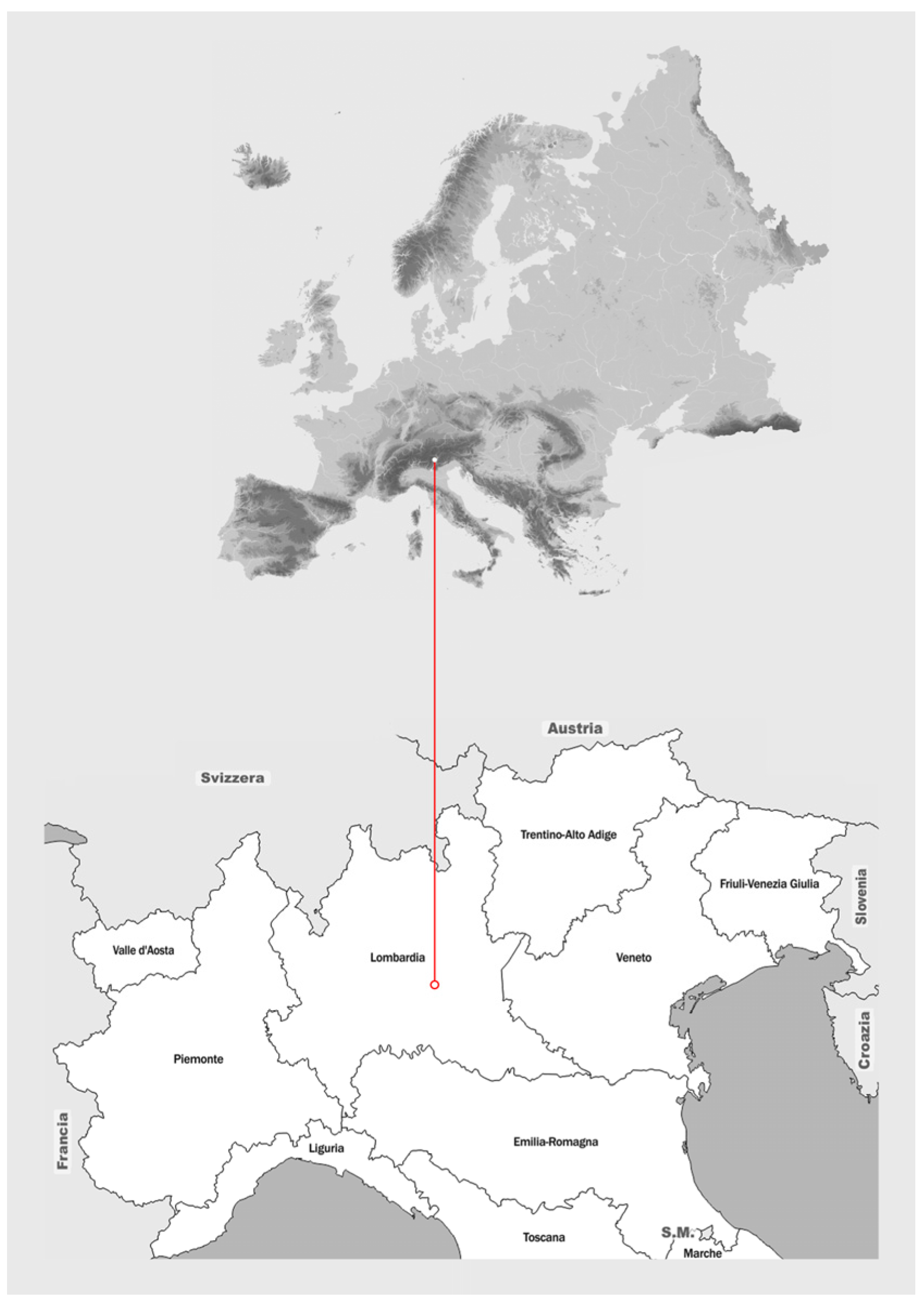

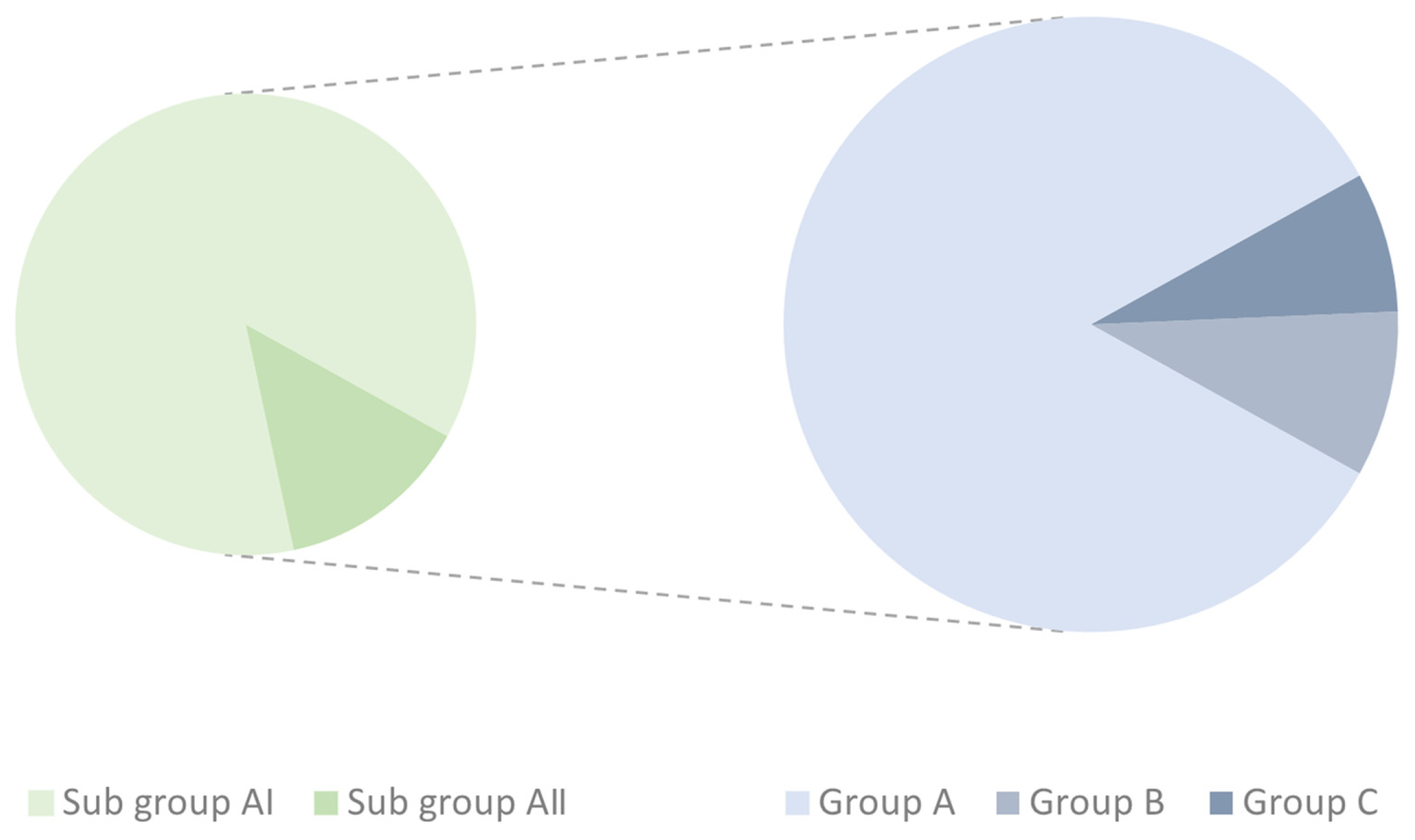
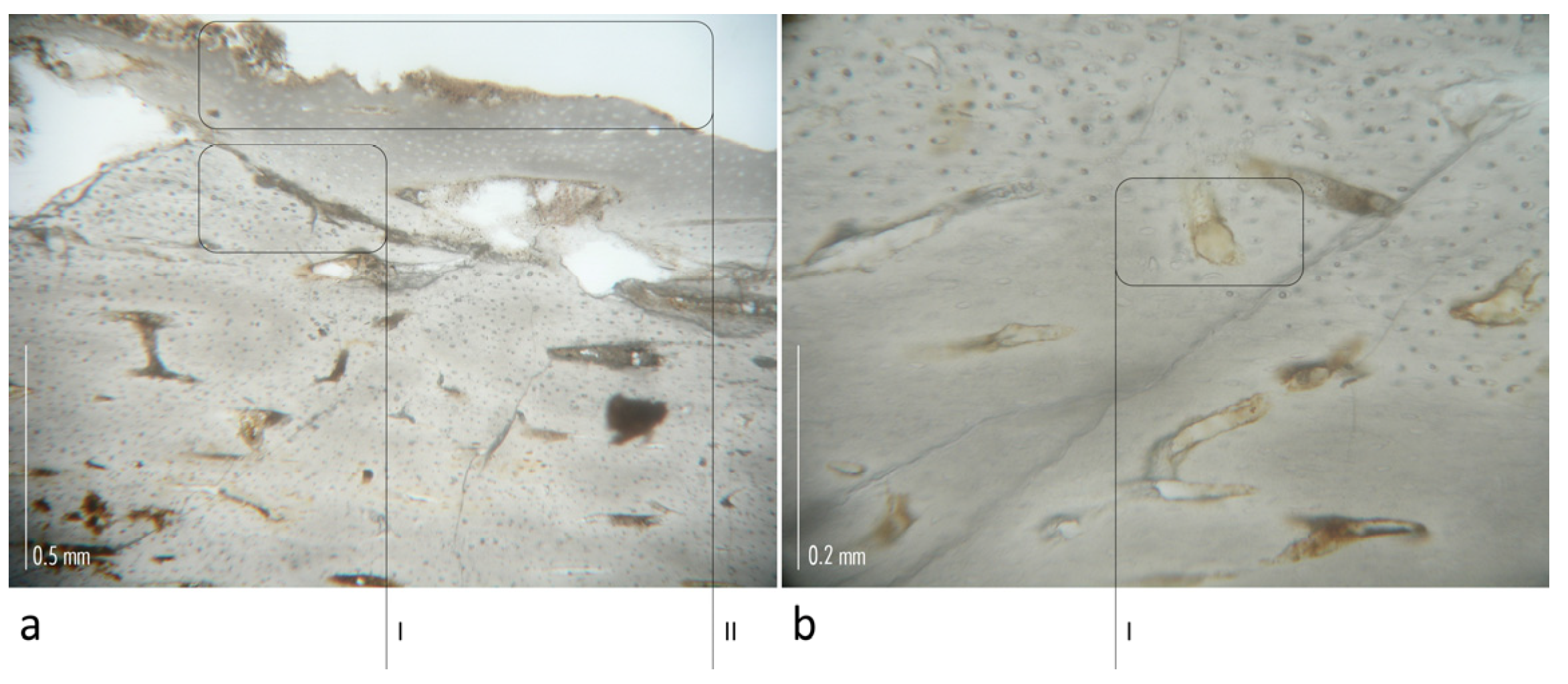
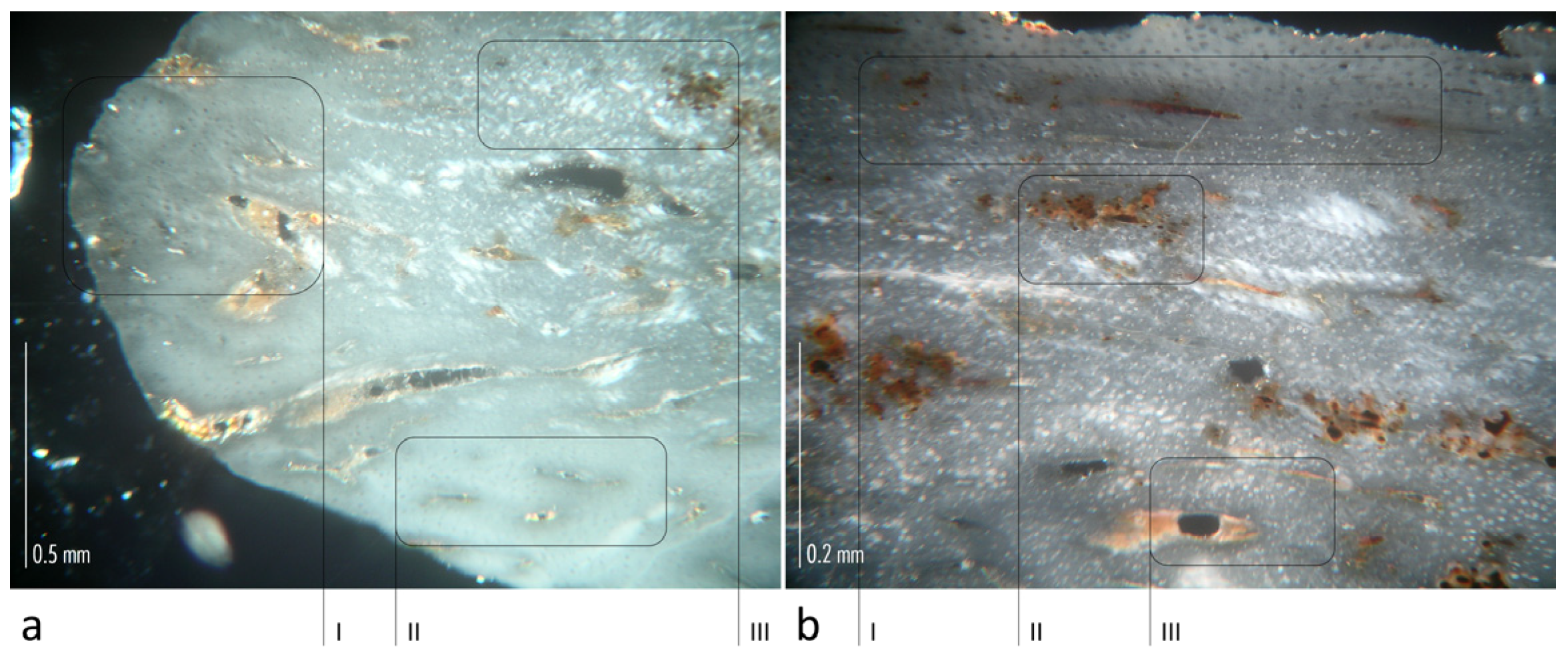
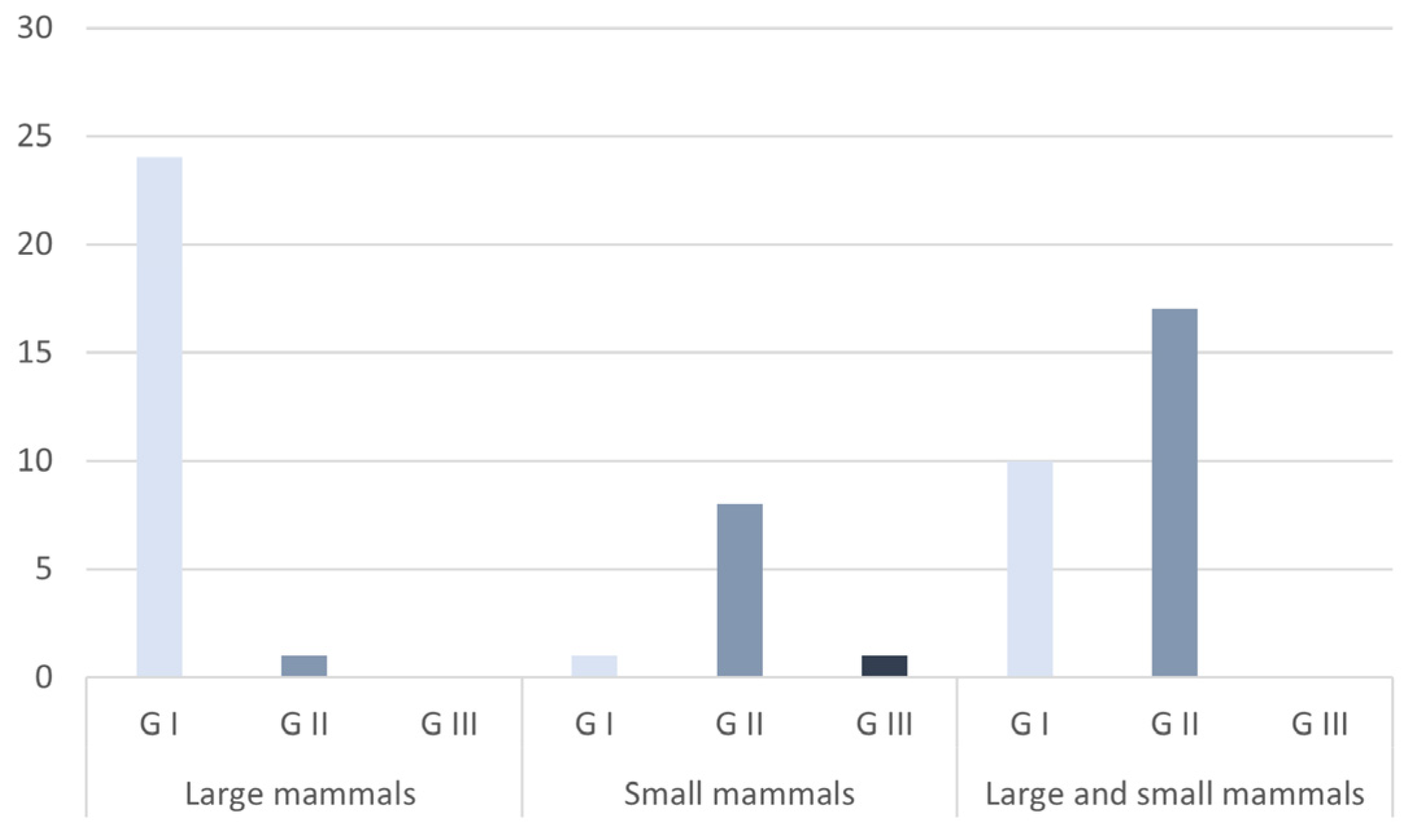
| Region | Province | Location | n Subjects |
|---|---|---|---|
| Lombardy | Varese | Golasecca (1954) | 1 |
| Lombardy | Varese | Golasecca, collezione Cesare da Sesto | 2 |
| Lombardy | Varese | Golasecca, Monsorino (1985–1986) | 6 |
| Lombardy | Varese | Sesto Calende, Cascina Bassoni (1958) | 1 |
| Lombardy | Varese | Sesto Calende, Cascina Stallazzo | 1 |
| Lombardy | Varese | Sesto Calende, collezione Bellini | 13 |
| Lombardy | Varese | Sesto Calende, collezione Mattana | 2 |
| Lombardy | Varese | Sesto Calende, loc. Mambrino (1986) | 2 |
| Lombardy | Varese | Sesto Calende, loc. Mulini Bellaria (1977–1981, 1995, 2004) | 21 |
| Lombardy | Varese | Sesto Calende, loc. Mulini, via Sempione (2005) | 2 |
| Lombardy | Varese | Sesto Calende, loc. Mulini, via Beltrami (1983) | 1 |
| Lombardy | Varese | Sesto Calende, loc. Presualdo (1983–1986, 1994, 1997) | 38 |
| Lombardy | Varese | Sesto Calende, via Bellaria–via Marconi (1989) | 1 |
| Lombardy | Varese | Sesto Calende, via Moncenisio (1995–1996) | 16 |
| Lombardy | Varese | Sesto Calende, via Montrucco (1995, 2003) | 9 |
| Lombardy | Varese | Sesto Calende, via Motte (1999) | 1 |
| Lombardy | Bergamo | Brembate Sotto, Strada Provinciale Osio-Trezzo (1888) | 1 |
| Lombardy | Bergamo | Caravaggio, Tangenziale Ovest, via Einaudi (2013) | 1 |
| Lombardy | Como | Como, Ca’ Morta (fino al 1981) | 54 |
| Lombardy | Como | Como, Nuovo Ospedale Sant’Anna (2007) | 2 |
| Lombardy | Como | Como, via Tito Livio (1996) | 7 |
| Lombardy | Brescia | Urago d’Oglio, loc. Cascina Giardina (2009) | 4 |
| Lombardy | Pavia | Garlasco, Madonna delle Bozzole (1994) | 3 |
| Piedmont | Novara | Castelletto Ticino (1959) | 16 |
| Piedmont | Novara | Castelletto Ticino, loc. Motto d’Egro (1984) | 1 |
| Piedmont | Novara | Castelletto Ticino, collezione Cesare da Sesto | 1 |
| Piedmont | Novara | Dorbié Superiore, loc. Cascina Riviera (1987) | 5 |
| Piedmont | Novara | Castelletto Ticino, loc. Cascina Brua, via Ardeatine (2009) | 25 |
| Piedmont | Novara | Castelletto Ticino, loc. Forcetto (1986) | 2 |
| Piedmont | Novara | Castelletto Ticino, via Valloni (2005–2006) | 3 |
| Piedmont | Novara | Castelletto Ticino, proprietà Guenzi, via Beati (2001) | 1 |
| Piedmont | Novara | Castelletto Ticino, proprietà Iacomella, via Valsesia (2002) | 5 |
| Piedmont | Novara | Castelletto Ticino, via Repubblica (2002) | 3 |
| Piedmont | Novara | Castelletto Ticino, via Aronco (1986, 1988–1989) | 12 |
| Piedmont | Novara | Castelletto Ticino, via del Maneggio (2001–2003) | 32 |
| Piedmont | Novara | Castelletto Ticino, via Fermi (2014) | 1 |
| Piedmont | Novara | Castelletto Ticino, via Ramacci (1998–2000) | 3 |
| Piedmont | Novara | Pombia, Cimitero (1987) | 2 |
| Piedmont | Novara | Pombia, loc. Planca, via Veneto (1993) | 5 |
| Piedmont | Novara | Pombia, proprietà Baù, loc. Quara (1994–1995) | 8 |
| Total subjects | 314 |
| Ranges of Haversian Canal Diameter (µm) | |||
|---|---|---|---|
| Taxon | Min | Max | Mean |
| Rat | / | <10 | |
| Deer | / | / | <10 |
| Rabbit | / | / | 10–20 |
| Cat | / | / | 20 |
| Dog | 15 | 50 | 35 |
| Pig | / | / | 35 |
| Cow | 15 | 55 | 37 |
| Goat | 18 | 70 | 42 |
| Sheep | 19 | 120 | 70 |
| Human | 30 | 175 | 105 |
| Ranges of Haversian System Diameter (µm) | |||
|---|---|---|---|
| Taxon | Min | Max | Mean |
| Rat | / | / | 70 |
| Deer | / | / | / |
| Rabbit | / | / | 100 |
| Cat | / | / | 160 |
| Dog | 125 | 175 | 155 |
| Pig | / | / | / |
| Cow | 155 | 250 | 210 |
| Goat | 55 | 320 | 190 |
| Sheep | 80 | 360 | 220 |
| Human | 180 | 320 | 260 |
| Group/Subgroup | Grave | TS 1 | TS 2 | TS 3 | Period | |||
|---|---|---|---|---|---|---|---|---|
| Plexiform | TI | Plexiform | TI | Plexiform | TI | |||
| A II | 1 | Yes | b | Yes | b | Yes | b | G I |
| A II | 2 | No | ND | Yes | c | / | / | G III |
| A II | 3 | / | / | Yes | b | Yes | b | G I |
| A II | 4 | No | ND | / | / | / | / | G I |
| A II | 5 | Yes | b | Yes | b | Yes | c | G II |
| A II | 6 | Yes | b | No | ND | / | / | G II |
| A II | 7 | No | a | No | a | / | / | G II |
| A II | 8 | No | a | No | ND | No | a | G I |
| A II | 9 | Yes | c | Yes | / | Yes | b | G II |
| A II | 10 | No | ND | No | ND | / | / | G I |
| A II | 11 | Yes | b | Yes | b | Yes | b | G I |
| A II | 12 | / | / | / | / | / | / | G II |
| A II | 13 | No | ND | / | / | / | / | G II |
| A II | 14 | Yes | c | / | / | Yes | c | G II |
| A II | 15 | No | ND | Yes | b | Yes | c | G I |
| A II | 16 | Yes | b | Yes | / | / | / | G I |
| A II | 17 | No | ND | No | ND | No | ND | G I |
| A II | 18 | Yes | c | Yes | b | Yes | c | G I |
| A II | 19 | No | ND | / | / | No | a | G I |
| A II | 20 | / | / | No | ND | / | / | G II |
| A II | 21 | Yes | / | Yes | b | No | a | G I |
| A II | 22 | Yes | b | / | / | Yes | b | G I |
| A II | 23 | No | ND | No | ND | / | / | G II |
| A II | 24 | / | / | / | / | Yes | c | G II |
| A II | 25 | No | ND | Yes | b | / | / | G I |
| A II | 26 | No | ND | No | a | Yes | b | G II |
| A II | 27 | No | ND | No | ND | / | / | G I |
| A II | 28 | / | / | / | / | No | ND | G I |
| A II | 29 | Yes | c | Yes | / | Yes | b | G II |
| A II | 30 | No | ND | No | a | / | / | G II |
| A II | 31 | Yes | b | Yes | b | / | G I | |
| A II | 32 | / | / | No | ND | Yes | b | G I |
| A II | 33 | No | ND | No | ND | No | a | G II |
| A II | 34 | / | / | / | / | No | ND | G I |
| B | 1 | Yes | c | Yes | c | Yes | b | G II |
| B | 2 | No | a | Yes | c | Yes | c | G II |
| B | 3 | / | / | / | / | No | ND | G I |
| B | 4 | Yes | b | Yes | c | Yes | b | G II |
| B | 5 | Yes | b | Yes | / | Yes | b | G I |
| B | 6 | Yes | b | Yes | c | Yes | b | G I |
| B | 7 | Yes | c | Yes | c | Yes | b | G II |
| B | 8 | No | ND | No | a | / | / | G II |
| B | 9 | Yes | / | Yes | b | / | / | G I |
| B | 10 | Yes | b | Yes | c | Yes | b | G I |
| B | 11 | / | / | / | / | Yes | b | G I |
| B | 12 | Yes | b | Yes | b | Yes | c | G I |
| B | 13 | Yes | b | Yes | c | Yes | c | G II |
| B | 14 | / | / | No | a | / | / | G II |
| B | 15 | Yes | b | Yes | b | Yes | b | G I |
| B | 16 | / | / | Yes | c | Yes | b | G I |
| B | 17 | Yes | c | / | / | Yes | c | G II |
| B | 18 | Yes | b | Yes | c | Yes | / | G II |
| B | 19 | Yes | b | Yes | / | Yes | b | G I |
| B | 20 | Yes | b | Yes | c | No | a | G I |
| B | 21 | Yes | c | Yes | / | Yes | b | G II |
| B | 22 | Yes | b | Yes | b | / | / | G I |
| B | 23 | / | / | / | / | / | / | G I |
| B | 24 | Yes | b | Yes | c | Yes | / | G II |
| B | 25 | No | ND | / | / | / | / | G II |
| B | 26 | Yes | c | Yes | b | Yes | b | G I |
| C | 1 | Yes | / | / | / | Yes | c | G II |
| C | 2 | Yes | b | Yes | c | Yes | b | G II |
| C | 3 | Yes | b | Yes | c | / | / | G II |
| C | 4 | Yes | / | Yes | b | Yes | c | G I |
| C | 5 | No | ND | Yes | c | Yes | c | G II |
| C | 6 | Yes | b | Yes | / | Yes | b | G I |
| C | 7 | / | / | Yes | c | Yes | b | G II |
| C | 8 | Yes | / | Yes | c | Yes | b | G II |
| C | 9 | Yes | b | Yes | b | Yes | b | G I |
| C | 10 | Yes | b | Yes | b | Yes | / | G I |
| C | 11 | Yes | b | / | / | Yes | b | G I |
| C | 12 | Yes | b | Yes | b | Yes | c | G I |
| C | 13 | Yes | b | Yes | b | Yes | b | G I |
| C | 14 | Yes | b | / | / | Yes | b | G I |
| C | 15 | / | / | Yes | b | Yes | c | G II |
| C | 16 | Yes | b | Yes | c | Yes | b | G II |
| C | 17 | Yes | c | Yes | / | Yes | b | G II |
| C | 18 | Yes | b | No | ND | Yes | / | G I |
| C | 19 | Yes | b | Yes | b | / | / | G I |
| C | 20 | No | ND | Yes | c | Yes | c | G II |
| C | 21 | Yes | c | Yes | c | Yes | c | G III |
| C | 22 | Yes | b | / | / | Yes | b | G I |
Disclaimer/Publisher’s Note: The statements, opinions and data contained in all publications are solely those of the individual author(s) and contributor(s) and not of MDPI and/or the editor(s). MDPI and/or the editor(s) disclaim responsibility for any injury to people or property resulting from any ideas, methods, instructions or products referred to in the content. |
© 2023 by the author. Licensee MDPI, Basel, Switzerland. This article is an open access article distributed under the terms and conditions of the Creative Commons Attribution (CC BY) license (https://creativecommons.org/licenses/by/4.0/).
Share and Cite
Larentis, O. Human, All Too Human: Differentiating Non-Human from Human Bones in Protohistoric Cremation Contexts from Northern Italy. Heritage 2023, 6, 647-661. https://doi.org/10.3390/heritage6010034
Larentis O. Human, All Too Human: Differentiating Non-Human from Human Bones in Protohistoric Cremation Contexts from Northern Italy. Heritage. 2023; 6(1):647-661. https://doi.org/10.3390/heritage6010034
Chicago/Turabian StyleLarentis, Omar. 2023. "Human, All Too Human: Differentiating Non-Human from Human Bones in Protohistoric Cremation Contexts from Northern Italy" Heritage 6, no. 1: 647-661. https://doi.org/10.3390/heritage6010034
APA StyleLarentis, O. (2023). Human, All Too Human: Differentiating Non-Human from Human Bones in Protohistoric Cremation Contexts from Northern Italy. Heritage, 6(1), 647-661. https://doi.org/10.3390/heritage6010034







